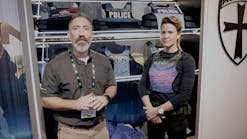Insights from a Life Protection Expert & Trends of the Body Armor Market
Marcio Manique serves as the Global Business Director for the DSM Dyneema's Life Protection business sector and is responsible for leading the marketing, sales and technical organizations in the Personal Protection and Vehicle Protection industry segments. With extensive knowledge of market trends in the Life Protection sector and a deep insight into the superior performance of Dyneema® technology Marcio works closely with industry leaders around the world to develop next generation armor solutions.
Marcio joined DSM in 2015, after held a number of leadership positions in Marketing, Sales and Technology in Latin and North America within Life Protection industry for more than 10 years. He is a recognized expert in ballistic technology, leveraging his Six Sigma Master Black background to develop commercial and technical innovation, holding prestigious industry awards in sustainability and marketing. Marcio also holds an Engineering major degree in Metallurgy honored with several graduation awards by academic and industry institutions, post-grade in Materials Science and Master of Business Administration & Economics from University of Sao Paulo.
How large are the global markets for law enforcement and defense?
MM: Although exact figures are not publicly available, the number of law enforcement officers worldwide is at least as large as the number of people in defense. Like their military counterparts, law enforcement personnel need protection against ballistic threats.
According to the Swedish International Peace Research Institute, “World military expenditure in 2014 was an estimated $1,776 billion. The total was equivalent to 2.3 percent of world gross domestic product (GDP, Military Expenditure. Stockholm International Peace Research Institute).” The current global budget for armored vehicles and personal protection, according to Strategic Defense Intelligence, is between $20 and $25 billion. The ballistic materials used in these segments play a very significant role.
Which life protection market sectors do you expect to grow fastest over the next few years?
MM: Let’s start with law enforcement. At DSM Dyneema, we see major potential and fast growth in this sector because of high-growth economies that are driving the expansion of cities, and greater investment in equipment, particularly through modernization programs. Law enforcement organizations today require a broader range of life protection technologies due to higher threat levels, different types of regional issues – from narcotics trafficking to gangs to refugees – and new types of weapons. As a result, many cities are expanding their police forces and their budgets for new equipment.
Second, we expect the majority of growth in the defense sector to come from modernization programs that require new technologies. Many countries, such as the U.S., United Kingdom, Brazil and India, are modernizing their militaries. Although currently the need for additional troops for large, global conflicts seems to be decreasing, unrest and the growing threat of terrorism around the world are driving the need for advances in new technology. This scenario is also the reason why opportunities for growth in personal protection surpass those in vehicle protection, although the latter is still very important.
A third growth sector is private security. Security firms used to focus almost exclusively on banks and businesses, but now private citizens, residential buildings and even neighborhoods are hiring security services to augment law enforcement protection. For example, in Brazil alone there are 1.5 million private security personnel. Factors driving this trend include greater disposable income that allow private citizens to safeguard themselves and their property, perception of increased threats due to instant information access and a wider range of available security services.
Which global market trends are driving this growth?
MM: In our view, the most important trend with regards to modernization is weight reduction. Decision makers are looking for lighter-weight life protection equipment – vests, helmets, inserts – to increase comfort and freedom of movement for their personnel. In ballistic protection, any weight reduction greater than 10 percent represents a major benefit. When a new technology can deliver 20 percent or even 35 percent less weight at the same level of ballistic performance, law enforcement and military organizations typically want to purchase it.
Material technologies that can reduce weight by significant percentages are very important when designing body armor to accommodate gender, ethnic and age differences – for example, to create protective gear for women vs. men in military combat roles, or to design for Asian vs. European body types. Even when you compare military with law enforcement personnel, there are significant differences. Military forces tend to be younger and more homogeneous, while law enforcement organizations have older as well as young members. Differences also come into play when considering climate and terrain.
DSM Dyneema provides designers with multiple material solutions featuring exceptional weight reduction so manufacturers can tailor life protection products with these variables in mind.
In addition to weight reduction, which properties lead the list of must-haves for next-generation body armor?
MM: Of course, strength is critical in ballistic protection, and Dyneema® ultra-high molecular weight polyethylene (UHMWPE) is the world’s strongest fiber. We offer grades of Dyneema® fiber with different areal densities to meet the needs for improved flexibility and comfort. In effect, we are giving designers a new toolbox of materials so they can customize their products to provide greater comfort, higher protection, lighter weight, greater flexibility and more.
What about new ballistic threats that call for new life protection technologies?
MM: In addition to the need to protect against rifles, we see special rounds as an emerging ballistic threat around the world. Special rounds for handguns and rifles have higher penetration power and fragment more than standard rounds. Unfortunately, they are spreading quickly around the world. Customers are coming to us asking for new materials that will protect against special rounds. It’s a constant race between the criminals and the life protection industry.
Is the proliferation of special rounds a reason for the globalization of ballistic standards?
MM: Yes, that is one factor. Another is greater collaboration among law enforcement agencies. We see U.K. law enforcement leaders spending time with the National Institute of Justice (NIJ), and U.S. law enforcement agencies talking about U.K. test protocols, for example. Emerging nations also see the value of these international standards, but typically they tailor them to local specifications. That is why we are still a long way off from a single worldwide standard – there are too many variations across markets. Plus, there is no harmonization effort or initiative to implement a single standard. Finally, while it is recognized globally, the NIJ standard is funded by American taxpayers, so it will remain U.S. centric.
Which life protection applications are the focuses of DSM Dyneema’s investments today, and why?
MM: We are concentrating on all three major categories of life protection – helmets, soft ballistics (vests) and insert plates – because they offer significant opportunities for growth. The helmet sector is currently undergoing a transformation as legacy products based on the Army model are replaced by lighter designs. Demand for insert plates for soft vests is growing because of law enforcement’s need for protection against AK-47s, AR-15s and other types of assault rifles that have been used in a number of recent incidents. Both law enforcement and the military are purchasing vests that provide less weight and greater comfort as part of modernization programs, as I mentioned.
Although these items are typically purchased in this order – vest, helmet and then insert plates – they all play a key role in full protection.
In which geographic markets do you see the greatest growth potential?
MM: The U.S. is the largest ballistic market in the world and continues to be a major source of business. While U.S. defense budgets are being cut, overall spending is still significant. The drive to improve soldier protection is also a key factor. Demand in Europe is growing, primarily due to social tensions, terror threats and other related issues. In other regions, such as APAC, there are programs to upgrade soldier protection; while the markets may be smaller there is significant, steady growth. In the Middle East, regional tensions are driving growth.
DSM Dyneema also sees opportunity in high-growth economies such as Southeast Asia, India and Brazil. However, these markets are looking for value and affordability, so are balancing performance features with material costs. One way we are addressing this requirement is with our new Dyneema® Anti Stab Technology, which can be used to design multi-threat protective gear that delivers much lighter weight and greater comfort than other anti-stab materials. Our technology not only targets specific threats – such as stabbings – but also promotes vest use to optimize return on the investment.
While we have a global presence, we are looking at expanding our manufacturing locations beyond Europe and the United States to support the needs of high-growth economies.
As high-modulus polyethylene (HMPE) gains greater market share, what do you see as the future of aramid?
MM: This will depend largely on technology, application needs and market forces. Each fiber has special properties. Dyneema® fiber is the strongest, and is growing fast. Aramid, though, does still have a place in the market for the short to medium term. However, several competitors have invested in HMPE tape for ballistic applications, and HMPE is fast becoming the material of choice. The past may offer a hint: nylon was replaced by aramid, and aramid may soon be replaced by HMPE. Simply expressed, Dyneema® is the next generation armor technology.
What is in your innovation pipeline?
MM: Our pipeline is based on light weight, comfort and higher performance, as well as meeting the needs of specific markets. We continue to pursue radical innovations while providing incremental innovations for local market needs.



